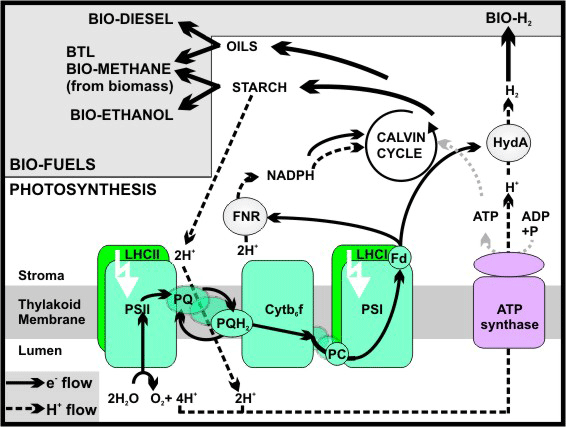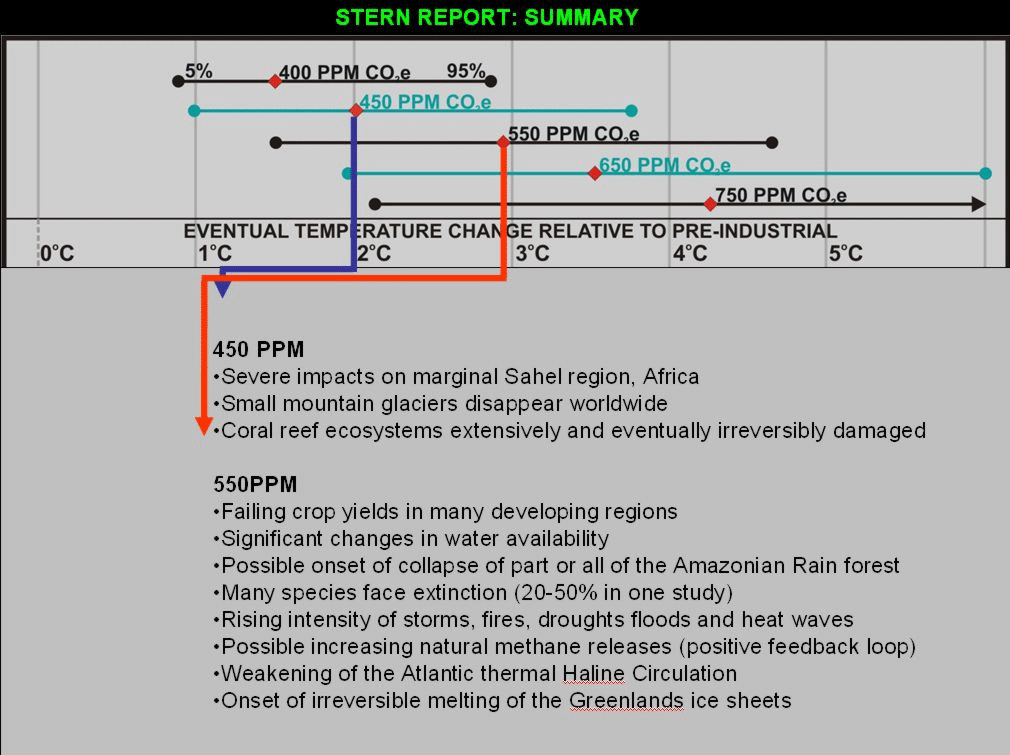The Consortium
Background of the Solar Bio-Fuels Consortium
Climate Change and the Need to Replace Fossil Fuels
The extensive Intergovernmental Panel on Climate Change (IPCC) and Stern report provide the most comprehensive analyses of the effects of climate change, its economic impacts, and the importance of developing clean fuels for the future.
The Focus of the Solar Bio-Fuels Consortium: Clean Fuels for the Future
Rapid implementation of clean energy systems is needed to facilitate CO2 stabilisation: In order to stabilise CO2 levels between 450 and 550 ppm it is predicted that we are faced with the challenge of installing systems capable of producing energy free of CO2 emissions, at a level almost equivalent to ~50-75% current global energy demand in 2005 (15 TW), in 20 years time (Hoffert et al. 1998).
Green algae and advanced bioreactor systems have significant practical and economic advantages for bio-fuel production over traditional crop plants. To facilitate the efficient development of algal bio-fuels processes, such as the production of bio-hydrogen, bio-diesel, biomass for BTL and biomass for bio-methane, Ben Hankamer and Olaf Kruse established the Solar Bio-Fuels Consortium through the commercialisation wing of the Institute for Molecular Bioscience (IMB) - UniQuest. This consortium now includes 8 groups: Ben Hankamer (The University of Queensland), Olaf Kruse (Universität Bielefeld, Germany), Clemens Posten (Universität Karlsruhe, Germany), Tony Larkum (The University of Sydney), Ute Marx (The University of Queensland), Michael Hippler (Universität Münster), Tony Larkum (The University of Sydney), Peter Nixon (Imperial College London) and Christian Wilhelm (University of Leipzig), and continued expansion is planned. Collectively, we conduct bio-discovery, structural biology, molecular biology, microbiology, genomics, transcriptomics, proteomics, metabonomics, culture optimisation and bioreactor scale-up within a coordinated research program. The consortium therefore provides an extensive set of skills and facilities and a single point of contact for industry as well as a network of international links.
Reference:
M. Hoffert, K. Caldeira, A. Jain, E. Haites, L. Harvey, S. Potter, M. Schlesinger, S. Schneider, R. Watts, T. Wigley, D. Wuebbles, Energy implications of future stabilisation of atmospheric CO2 content, NATURE, 1998, 395, 881-884.
Photosynthesis is Central to All Bio-Fuel Production
Photosynthesis plays an absolutely central role in all bio-fuel production processes as it is the first step in the conversion of solar energy (light) to chemical energy and therefore ultimately responsible for driving the production of the feed stocks required for fuel synthesis (Fig.1): protons & electrons (for bio-H2), sugars & starch (for bio-ethanol), oils (for bio-diesel) and biomass (for BTL & bio-methane). Consequently, any increase in photosynthetic efficiency will enhance the competitiveness of bio-fuel production in general.
In higher plants and green algae, light is captured by specialised Light Harvesting Complex proteins,
referred to here as LHCI and LHCII, (Fig.1) which confer the ability to adapt to changing light levels. The
excitation energy is then funnelled to the photosynthetic reaction centres of photosystem I (PSI) and photosystem
II (PSII). PSII uses this energy to drive the photosynthetic water splitting reaction, which converts water into
protons, electrons and oxygen. The electrons are passed along the photosynthetic electron transport chain (Fig.1, thin solid black arrows) via plastoquinone (PQ), cytochrome b6f (Cyt b6f), photosystem I (PSI), and ferredoxin (Fd)
and on to NADPH. Simultaneously, protons are released into the thylakoid lumen by PSII and the PQ/PQH2 cycle (Fig.1; proton flow
indicated by thin black dashed arrows). This generates a proton gradient, which drives ATP production via
ATP synthase. The protons and electrons are recombined by ferredoxin-NADP+ oxidoreductase (FNR) to produce NADPH.
NADPH and ATP are used in the Calvin cycle and other biochemical pathways to produce the sugars, starch, oils and
other bio-molecules (which collectively form biomass) that are required to produce bio-ethanol, bio-diesel, bio-methane- and BTL-based bio-fuels. Alternatively in some photosynthetic micro-organisms like the green alga Chlamydomonas reinhardtii the protons and electrons extracted from water (or starch) can be fed to the
hydrogenase (HydA) via the electron transport chain to drive the direct production of bio-H2 (Fig.1).

Figure 1: The central role of photosynthesis in bio-fuel production.
Advantages of Algal Bioreactors
Economic Viability: The potential of solar bio-fuel production is highlighted by the fact that even using current technology, Brazilian sugar-cane-based and US corn-based bio-ethanol production are cost competitive at oil prices of US $40 and US $60 per barrel, while the equivalent for biodiesel is US $80 (The Economist, 2006). Thus, even modest increases in photosynthetic efficiency are expected to yield significant increases in economic competitiveness. Algae have various advantages over classical crop plants for the production of biofuels and can be engineered to increase photosynthetic effciency.
Reducing arable land use for bio-fuel production: A common concern related to bio-fuels is that as their production capacities increase, so will the competition with agriculture for arable land. Similarly rainforest regions are being cleared to make room for the palm plantations required for the production of oil for bio-fuels. In contrast algal bioreactors are designed to be sited on non-arable land, eliminating this competition and opening up new economic opportunities for arid regions.
Short life cycles increase yield: In contrast to conventional crop plants, which yield a harvest once or twice a year, the micro-algae have a life cycle (~1-10 days depending on the process), with the result that multiple or continuous harvests with increased yield are be produced.
Reducing H2O use in agriculture: Conventional crops used for bio-fuel production require substantial amounts of fresh water. Due to the increased photosynthetic efficiency of engineered algae and the use of closed bioreactors, considerable savings in net water use can be achieved.
Coupling clean fuel production to desalination: Marine and salt tolerant algae can extract hydrogen (as protons and electrons) and oxygen from water. Upon combustion of hydrogen and oxygen fresh water is produced. Consequently by using stationary fuel cells that use hydrogen and oxygen to feed electricity into the national grid, energy generation can be coupled with desalination.
Environmentally sensitive waste disposal: The algal biomass generated in algal bioreactors can be gasified to produce a range of bio-fuels. The CO2 released during gasification is no more than that previously absorbed, making this type of process CO2 neutral. In this way biological GMO waste can also be effectively disposed of in an environmentally sensitive way.
Reference:
Bakersfield, California and Calgary, Alberta, The oil industry: Steady as she goes, Why the world is not about to run out of oil, The Economist, 2006, London, p.65-67.
The Intergovernmental Panel on Climate Change (IPCC) has provided probably the most authoritative reviews of the effects of climate change. The IPCC provides the following explanation of its work (http://www.ipcc.ch/pdf/assessment-report/ar4/syr/ar4_syr_cover.pdf):
"The Intergovernmental Panel on Climate Change (IPCC) was set up jointly by the World Meteorological Organization and the United Nations Environment Programme to provide an authoritative international statement of scientific understanding of climate change. The IPCC?s periodic assessments of the causes, impacts and possible response strategies to climate change are the most comprehensive and up-to-date reports available on the subject, and form the standard reference for all concerned with climate change in academia, government and industry worldwide. Through three working groups, many hundreds of international experts assess climate change in this Fourth Assessment Report."
This report can be obtained from http://www.ipcc.ch/publications_and_data/publications_and_data_reports.shtml#.T59ADtmseAo
An 18 page summary for policy makers can be obtained from http://ipcc-wg1.ucar.edu/wg1/Report/AR4WG1_Print_SPM.pdf.
The importance of the IPCC work for the Solar Bio-fuels Consortium, is that it highlights the environmental importance for the development of clean fuels for the future. However it took the Stern report (2006) to convincingly demonstrate that acting to combat climate change not only makes environmental but also economic sense.
The Economics of Climate Change - Stern Report
In October 2006 Sir Nicholas Stern (Chief Economist and Senior Vice President of the World Bank from 2000-2003) released the extensively reported Stern Review on the Economics of Climate Change. This extensive review is widely accepted to be the most authoritative summary available on the "economic effects of climate change" and is based on the rigorous scientific evaluation of its predicted effects provided by the Intergovernmental Panel on Climate Change and other sources.
The predicted effect of climate change include melting of the polar ice caps (by ~2100), sea level rises, disruption of ocean currents (e.g. Gulf Stream), extreme weather patterns (e.g. droughts, flooding and hurricanes) and large scale species extinction. Figure 2 shows an adaptation of the data presented in the Stern review, with the effects predicted to occur at atmospheric CO2 levels of 450 ppm and 550 ppm CO2 being highlighted. These suggest that it would be far safer to stabilise at 450 ppm than 550 ppm. Many scientists however think that unless very strong environmental policies are put in place quickly, we will only be able to stabilise at the 550 ppm level.
The importance of the Stern review lies in the fact that it defines the scale of the climate change problem, presents a path of action to prevent the worst of these effects and helps to establish a timetable within which to do so. Stern states "Taking strong action to reduce emissions - must be viewed as an investment [~1% GDP vs. 20% loss of GDP for inaction], a cost incurred now and in the coming few decades to avoid the risks of very severe consequences in the future." "This investment" [represents] "the pro-growth strategy for the longer term" and should enable a "policy to support innovation and deployment of low carbon technologies".

Figure 2: Adapted from Figure 2 of the Stern report-Executive summary.

